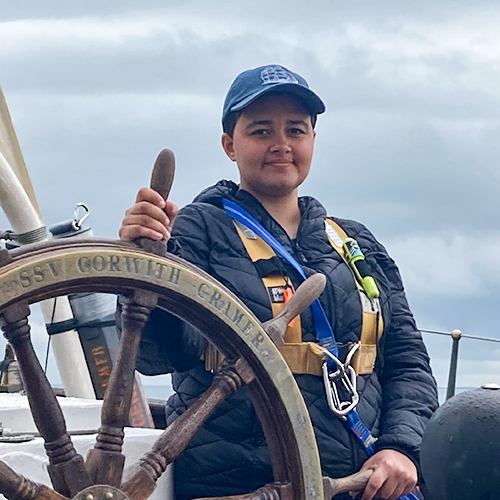PEP-II
PEP-II offers a second summer experience for students who have already completed a summer with us for PEP.
The goal of PEP-II is to expand upon the existing PEP internship and create a post-baccalaureate focused summer research opportunity in Woods Hole for researchers from underrepresented minority groups to develop the skills, networks, and experiences required to competitively enter the marine workforce or graduate school. The project also partners with public K-12 schools in Falmouth to develop marine and environmental science lesson plans.
2023 PEP-II Symposium
Thursday, August 10 from 8-930 in NOAA's Clark Conference Room (inside the Woods Hole Science Aquarium) at 166 Water St. Woods Hole.
Click here to watch the symposium recording on Youttube
8:00 - Welcome and Opening Remarks
Onjalé Scott Price, PEP Director
Nicole Cabana, Deputy Director of NOAA NMFS NEFSC
8:20 - Ayanna Mays
Hypoxia Tolerance in Menidia menidia
8:40 - José Cabral
Fin Whale Assessment of Habitat Use and Connectivity Relative to Marine Protected Areas in the Gulf of Maine: Implications for Management
9:00- AliciaYodlowsky
Buzzards Bay Salt Marsh Ecology and Anti-fouling Measures

Ayanna Mays
BS, Marine Biology and Ecology, University of Miami
Project Title: Hypoxia Tolerance in Menidia menidia
Mentors: Christopher Murray & Neel Aluru, Woods Hole Oceanographic Institution
Abstract:
Understanding how animals that inhabit coastal ecosystems might adapt to decreasing oxygen levels (HypOA) is a critically important area of research. One potential mechanism is multigenerational plasticity where parents pass down adaptive traits through non-genetic pathways in response to environmental conditions that they experience prior to spawning. We tested this hypothesis in the coastal fish, the Atlantic silverside (Menidia menidia). We conducted a laboratory experiment where pre-spawning adults were acclimated to either ambient conditions or hypoxic/acidified conditions (HypOA) during maturation. Offspring were then reared under both treatments in a factorial experiment to evaluate effects on survival and development. We found that adults exposed to HypOA conditions produced embryos that exhibited greater survival under low DO/high pCO2 conditions, indicating the potential for multigenerational plasticity. To explore this finding further, we employed RNA sequencing to
better understand treatment effects in offspring gene expression. Larvae reared under HypOA conditions showed broad expressional changes, resulting in >1,500 differential expressed genes (DEGs) affecting functional pathways related to hypoxic stress.. However, HypOA-treated offspring from different parental groups showed large differences in expressional patterns, with over 750 unique DEGs per group. Furthermore, larvae fertilized from HypOA-acclimated adults but not reared under HypOA conditions still exhibited transcriptional profiles similar to offspring directly exposed to HypOA. While we found no significant DEGs between these larvae and larvae from control parents, GSEA found similar enriched pathways including synaptic signaling, neuron development, and ion transport. This group’s expression profile seems to be an intermediary between that of control larvae with control parents and HypOA larvae with HypOA-acclimated parents. Though non-significant, it does suggest parental exposure has the potential to pass down environmentally adjusted genes that may allow for rapid adaptation.
Falmouth Public School Collaboration
FPS Teacher: Chinna Mapp
My public schools project uses the 5E method to effectively teach students about the scientific method. Using a combination of videos, graphics, PowerPoint, and my own research as an example, students will learn all of the components of the scientific method. To demonstrate their knowledge, students will play a trivia game and design their own hypothetical experiment within biology. The lesson will emphasize critical thinking by asking students to think beyond labeling parts of their experiment and will encourage students to be curious and ask questions about the world around them.

José Cabral
Undergraduate, Geophysics, University of Texas at El Paso
Project Title: Fin Whale Assessment of Habitat Use and Connectivity Relative to Marine Protected Areas in the Gulf of Maine: Implications for Management
Mentor: Sean Hayes & Danielle Cholewiak, NOAA Northeast Fisheries Science Center
Abstract:
Fin whales (Balaenoptera physalus) are frequent visitors to Marine Protected Area (MPA) habitats. The productive waters of New England serve as an essential foraging habitat for fin whales, with high site fidelity historically observed within Cape Cod Bay. The benefits of MPAs are assumed to be beneficial, although much remains unknown on how fin whales interact with MPA habitats. This study examines the tag-derived location and behavioral data to determine the habitat utilization of fin whales within and around the regional MPA network.
From June 30, 2022 to July 7, 2022, seven fin whales were fitted with a combination of SPOT365 and SPLASH10-333 satellite telemetry tags. The tags’ data comprised horizontal movement, depth, and diving behavior. The tags were deployed along the northern region of the Cape Cod Ocean Sanctuary and the southeastern region of Stellwagen Bank National Marine Sanctuary (SBNMS). The satellite telemetry tags had an average deployment time of 38.35 days. The fin whales displayed localized movements between SBNMS and the surrounding shallow waters. Dive depths were mostly concentrated below 25 meters, and due to the shallowness at SBNMS, a minority of dives occurred above 25 meters with the average maximum dive depth of 48.71 meters. The average dive duration was 5.2 minutes and the average maximum dive duration was 16.6 minutes. A positive non-linear correlation was observed between dive depth and dive duration. Foraging behaviors and site fidelity were determined using a state-space model and new insights are provided into fin whales’ formerly overlooked use of MPA habitats. As anthropogenic threats to marine habitats increase worldwide, this research aims at providing a baseline of habitat use analysis, which can be used to evaluate future changes in the existing structure and connectivity among the MPAs.
Falmouth Public School Collaboration
FPS Teacher: Kristina Woods
For my FPS collaboration, we developed a class curriculum exploring how marine sanctuaries and their role in commercial fishing negatively affect marine mammals. We presented this information by developing a Marine Protected Areas presentation, watching relevant videos, playing with NOAA interactive websites, and developing student activities. Afterwards, we led a student discussion and wrote letters to Congress.

Alicia Yodlowsky
BS, Agricultural and Environmental Systems, North Carolina Agricultural and Technical University
Project Title: Buzzards Bay Salt Marsh Ecology and Anti-fouling Measures
Mentors: Lara Gulmann and Rachel Jakuba, Buzzards Bay Coalition
Abstract:
Buzzards Bay Coalition monitors water quality across Buzzards Bay to assess the bay’s health. The data collected includes dissolved oxygen, salinity, and temperature. Buzzards Bay Coalition also conducts research on salt marsh crabs by setting pitfall traps to capture crabs. My first research project involved an analysis of the salt marsh crab data with the goal of answering the questions: 1) what species are found at which sites? 2) are more crabs captured on the salt marsh platform or near the creek? 3) does carapace width vary by site? On average, more crabs were captured on the platform than near the creek. This was interesting because upon visual inspection, more crabs are present near the creek than on the platform. We speculated that crabs may be able to swim to escape near-creek traps when the creek floods and fills the traps with water. Carapace width varied across sites, and species caught across sites also varied.
To conduct water quality monitoring, logging equipment is deployed at sites across Buzzards Bay. Marine organisms settle on the equipment (a process called biofouling), potentially obstructing the sensors. When this occurs, the data recorded on the loggers becomes inaccurate. My second project involved two experiments regarding biofouling. One examined how rapidly biofouling occurs, which determines how frequently the loggers must be cleaned. The second experiment tested the effectiveness of certain anti-fouling measures. Different sites experience different rates of biofouling; also, some anti-fouling measures are more effective than others. We tested the anti-fouling capacity of stockings and a nano-polymer spray. The stocking effectively prevented biofouling, whereas, the spray entirely failed to prevent biofouling. We also counted and identified the biofouling organisms present; we found high numbers of barnacles and colonial tunicates. Combating biofouling helps provide an accurate understanding of water quality across Buzzards Bay.
Falmouth Public School Collaboration
FPS Teacher: Caitlin Church
I worked with Caitlin Church, a 7th grade teacher at Lawrence School, to create an interactive educational map of Buzzards Bay. The map is designed to show the sites where Buzzards Bay Coalition does long-term water quality monitoring and research on salt marsh crabs. The map includes figures and images illustrating this research.
